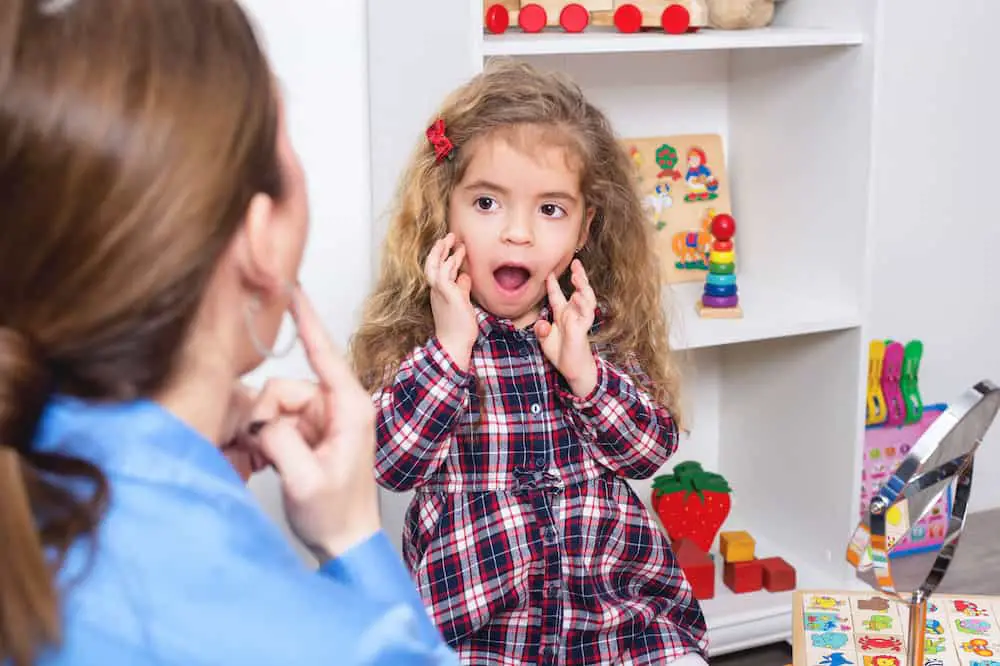Parents need to know the differences between a mixed receptive-expressive language disorder vs autism.
As one of the most commonly reported effects of autism, delayed speech can often be misinterpreted for something more severe.
Understanding both concerns can help you ensure that your children get the assistance they need to reach their developmental milestones.
Understanding Speech Development in Children
Before we get into the details of mixed receptive-expressive language disorder and autism, it’s important to remember that every child is different.
Some reach language milestones later, while others don’t reach these milestones at all.
By paying close attention to your child’s language use, you can determine whether professional help is required.
It’s important to note that although a child may show signs of speech delays, it doesn’t necessarily mean they have autism.
There are specific differences between social challenges and communication experienced in those with ASD than other language disorders.
Let’s get into the details that make mixed receptive-expressive language disorder and autism strikingly different.
What Is Mixed Receptive-Expressive Language Disorder?
The definition for mixed receptive-expressive language disorder is much like its name suggests.
Children with this disorder often find the expressive and receptive language communication areas lacking.
They will find it challenging to express themselves using language while also showing difficulty with understanding language.
This disorder can affect children from mild to severe.
In general, those with this disorder find it difficult to understand basic sentences and words.
What Causes Mixed Receptive-Expressive Language Disorder?
In most instances, children will acquire a mixed receptive-expressive language disorder as a result of developmental issues.
With that said, it’s important to remember that language acquisition doesn’t always correlate with a child’s intelligence.
There are many cases where children simply cannot communicate effectively with their peers.
Mixed receptive-expressive language disorder is also commonly experienced when children experience a neurological injury.
These injuries could include traumatic head injuries, seizures, or strokes.
Also, children with other developmental disorders are more likely to experience mixed receptive-language disorder.
What Are the Symptoms of Mixed Receptive-Expressive Language Disorder?
Several signs can indicate that your child may be dealing with this language disorder.
A few of the most common include:
- An inability to communicate needs, wants, or thoughts at the same level as their peers
- Exhibiting a limited vocabulary, especially compared to other children their age
- Can pronounce words but finds them difficult to put into a sentence appropriately
- Struggles consistently with using proper grammar and correct tense
- Genuinely cannot understand what’s being said to them
- Uses very few key terms when talking to others
What Is Autism?
Autism, also known as Autism Spectrum Disorder (ASD), is a disorder in which children express challenges with social skills.
It is often characterized by a display of repetitive behaviors as well as speech challenges and nonverbal communication.
There is a multitude of autism subtypes that can occur as a result of genetic and environmental factors.
This disorder is unique because children with ASD often have a varying set of challenges and strengths.
Also, ASD can manifest across a spectrum, from mild to severe, as some children can problem-solve while others are severely challenged.
Some individuals with ASD may require assistance with daily activities, while others need less support and live independently.
What Are the Symptoms of Autism?
As mentioned, the symptoms of autism can vary significantly from one person to the next.
Parents and medical professionals will often see signs of the disorder as early as two or three years of age.
In some cases, ASD can be diagnosed as early as 18 months.
Some of the most common symptoms of autism include:
- Gastrointestinal issues
- Abnormal emotional and mood-related reactions
- Delayed learning and cognitive skills
- Inattentive, hyperactive, or impulsive behaviors
- Delayed movement and cognitive skills
- Delayed language and learning skills

What Is the Difference Between Mixed Receptive-Expressive Language Disorder vs Autism?
It’s easy to assume that mixed receptive-expressive language disorder and autism are similar because of language difficulties.
However, autism is a disorder that comes with an assortment of additional concerns.
Not only is it a developmental disorder that affects language and cognitive abilities, but it can also cause physical challenges.
Children with autism can undoubtedly experience mixed receptive-expressive language disorder.
However, parents must remember that language disorders aren’t the cause of autism. One can occur independently of the other.
You can address mixed receptive-expressive language disorder with the assistance of a speech-language pathologist.
Through clinically proven techniques, trained professionals can help children acquire fundamental language skills.
Hopefully, children will be able to develop their abilities to where they can communicate more effectively.
Depending on the severity of a child’s autism, on the other hand, language reception and expression may not occur.
Still, with the assistance of a speech-language pathologist, there is an incredible number of cases where children can learn to express themselves more healthily.
How Can Language Disorders Be Treated?
Living with mixed receptive-expressive language disorder and autism can be challenging for many reasons.
Not only does it interfere with how children listen to and understand others but also in how they express themselves.
As you can imagine, it often leads to frustration and causes further delays in language acquisition and use.
However, with the help of a trained speech-language pathologist, children can begin working towards better communication.
Treatment for this disorder depends on the age of the child and the breadth of their condition.
Some children are better suited to one-on-one sessions with a speech therapist, while others benefit more from group sessions.
In general, the typical treatment plan for children with language disorders requires the following:
Professional Speech Therapy
Speech therapy is essential for children dealing with this language disorder.
It will most often be held in a comfortable clinical setting with activities led by a professional.
The child will work through an assortment of activities to begin learning language and how to use it appropriately.
Also, the speech-language pathologist will maintain a relaxed environment to encourage healthy learning.
They will often work through speech and language tasks and evaluations to help children speak clearly, slowly, and concisely.
At-Home Speech Therapy
Language learning is something that children should encounter in every environment, especially at home.
Parents are often a large part of language reception and expression, so expect plenty of homework to do as a family.
Similar to speech therapy, you’ll want to create a safe and comfortable environment for learning.
Using recommended toys and activities, you can assist your child with understanding basic instructions.
It’s also common for at-home speech therapy to include vocabulary acquisition to help your child better express their needs and wants.
With the help of healthy reinforcement techniques, you can further their language learning to meet the milestones for their age.
Access to Language Development Tools
Language development tools come in an assortment of shapes and sizes.
You might find unique toys designed specifically for language acquisition as well as books and computer programs.
By providing these engaging activities, children will learn a language in a fun and engaging way.
There are many tools that you can purchase to use at home.
In fact, you might even find the majority of which in a speech pathologist’s office.
Here are three of our top recommendations and how they can help with language development:
1. Noun Vocabulary Builder Flash Cards
Flashcards are a fabulous learning tool that every child with a speech development disorder should have access to.
With the Noun Vocabulary Builder Flash Cards, you can build a more extensive vocabulary with over 300 educational photos.
Parents can work through numerous animals, instruments, foods, transportation, and more.
With flashcards, you can implement a family-friendly activity filled with interactive fun.
Over time, your children will become more familiar with fundamental actions, emotions, and words.
Not to mention, the diversity of flashcards can significantly improve their learned vocabulary.
2. Stages Learning Materials Language Builder
Another fantastic solution for building language development is the Stages Learning Materials Language Builder.
This package comes with an assortment of 3D and 2D toys and activities for children to play with.
You’ll find flashcards, toy figures, and other items ideal for vocabulary learning and developing speech.
There are 48 realistic figurines made from child-safe materials, including animals, foods, and everyday objects.
Plus, parents will also have realistic flashcards with easily identifiable photos to assist children with learning basic everyday items.
3. BYJU’s Magic Workbooks
Depending on your child’s age, you might be looking for a more advanced way to assist them with language development and use.
In that case, BYJU’s Magic Workbooks is an excellent solution.
These premium-quality workbooks contain popular Disney characters, enticing children to develop language acquisition.
The workbooks are designed for children between four and six years old and contain many great activities.
They will learn how to read and express letter sounds, develop spatial awareness, and familiarize themselves with numbers.
For an even more interactive environment, you can pair the workbooks with their iPad for in-depth learning.
What makes these activities unique is the depth in which they teach children.
Every workbook can be adapted to your child’s learning ability to help them build fundamental skills.
Not only will they explore language but also math and reading.
With over 1,000 adventures to embark on, your children will explore interactive read-along stories, video lessons, and interactive quizzes.
Ask for Professional Help
Understanding the critical differences between mixed receptive-expressive language disorder vs autism is essential for every family.
Both disorders can occur independently, but they share a few common markers, such as language difficulties.
With the help of a trained professional, you can begin to work towards better language acquisition for your child to express less language frustration.




